PITTI PALACE
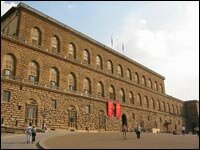
Palazzo Pitti |
This area, characterized by the Pitti Palace and the Boboli Gardens is one of the district with the highest density of museums and galleries. Palazzo Pitti was built in 1448 for Luca Pitti. The first plans were supposedly by Brunelleschi. It passed to the Medici family in 1549 and underwent numerous alterations over the years. Today it houses various interesting museums and galleries: The Gallery of Modern Art, The Palatine Gallery, The Argenti Museum, The Costume Gallery, The Coach Museum, The Ceramics Museum, the Royal Appartments and the Appartments of the Duchess of Aosta. The Gallery of Modern Art in Pitti Palace is located on the 2nd floor and is made up of 30 rooms. This gallery offers a complete overview of paintings from neo-classicism to the 20th century, with particular attention to the art changes in Tuscany. Included in the Gallery are some important example of sculptures, some works of foreign artists, and effective champions of 19th Century applied arts. Part of the collections from 1900 to 1945 will be showcased in the upstairs rooms of the Gallery, the so-called "Mezzanino degli Occhi," as soon as the temporary remodelling works will be terminated. The Palatine Gallery includes extraordinary masterpieces of the 16th and 17th centuries. The collection includes the work of Italian, Flemish, French and English artists, including Raffaello (with 11 famous works), the Florentine School (Fra' Bartolomeo, Andrea del Sarto, Pontormo, Rosso Fiorentino, Caravaggio, Rubens, Van Dyck, Guido Reni, Guercino, Maratta). The quality and particular arrangement of the works makes this collection unique. All the walls are totally covered with paintings, and the decoration is completed with golden stuccos. Each of the rooms in the gallery are furnished with beautiful consoles with prestigious marble layers or Florentine mosaics in hard stones.
|
BOBOLI GARDENS
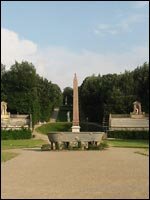
Boboli Gardens |
The Boboli Gardens, other characteristic of this area, were laid out for the Medici family after they bought Palazzo Pitti in 1549. In 1766 they were opened to the public. The part near Palazzo Pitti consist of box hedges clipped into symmetrical geometric patterns. These lead to wilder groves of ilex and cypress trees, planted to create a contrast between nature and artifice. Statues of different periods are located around the gardens and the vistas were projected to give views over Florence. Walking around this area, it’s possible to visit the Fortezza Belvedere, from which you’ll enjoy an enchanting view over the Boboli Gardens. The Fortress was designed in 1590 by Bernardo Buontalenti but originally it was built to defend Florence from the rival attacks. Later, it became the refuge for the Medici Grand Dukes.
|
CHURCH OF SANTO SPIRITO
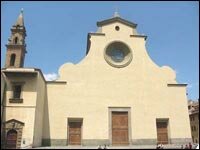
Church of Santo Spirito |
Interesting is the Church of Santo Spirito and its refectory (Cenacolo). The modest XVIII century façade of this church is due to be restored at any time; the original building was destroyed by fire in XIII century and in 1435 Brunelleschi was commissioned to project a new church for the Augustinians. Brunelleschi died too soon and the work was ended (not so successfully) by Antonio Manetti, Giovanni da Gaiole and Salvi d’Andrea. The interior presents an elaborate Baroque Baldacchino and an High Altar that are not so well enclosed in the armony of the church. Santo Spirito is decorated with works by Rosselli, Ghirlandaio, Lippi. The sacresty adjoining the vestibule was designed by Giuliano da Sangallo in 1489. The refectory (Cenacolo), is now a small museum. Inside is a fresco featuring “the Crucifixion” (1360-65), attributed to Carlo Orcagna.
|
CHURCH OF SANTA FELICITA

Church of Santa Felicita |
On the site of an Early-Christian cemetery stands the church of Santa Felicita. During the centuries this church had many alterations before Ferdinando Ruggieri, in 1736, gave it its present appearance. Some original Gothic features and the Vasari’s porch (1564) are unaltered.
|
PORTA ROMANA
In this area is located the largest and best kept gate of Florence: Porta Romana. It was built in 1330 to become a part of the last circle of the urban walls It has maintained the original iron doors and the Medici Family coat of arms and a marble plaque. It presents the original covered communication trench and a 15th century fresco. |
MUSEUM "LA SPECOLA"
Going on our tour in this area, we suggest a visit to the particular Museum “La Specola”. It’s housed in Palazzo Rottigiani (1775) , now used by the natural science faculty of Florence University. It has a zoological section displaying vast numbers of preserved animals, insects and fish, and anatomical section with realistic XVIII century wax models showing grotesque aspects of human physiology and disease. |
SAN FREDIANO IN CESTELLO
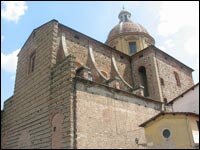
San Frediano in Cestello |
San Frediano district is the artisan's quarter, with the shops of many antiques dealers and restorers, and it is often associated with leather and wool industries. The homonymous church of San Frediano in Cestello with its large dome is a local landmark. It presents a bare stone exterior with a large dome surmounted by a lantern. It was rebuilt in 1680-89 by Antonio Maria Ferri in florentine baroque. Inside the cupola and the domed chapels were painted by 18th century masters. Nearby there is a stretch of the 14th century city walls, in good conditions. The ancient gate here located, Porta San Frediano, was built in 1324 and presents a tower overlooking the way to Pisa. Its door, completely realized in wood, have retained their original 14th century locks and detailed ironwork.
|
SANTA MARIA DEL CARMINE
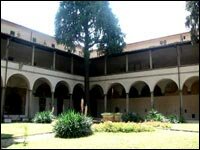
Church of Santa Maria del Carmine |
Another pretty church, Santa Maria del Carmine, with its interesting rough stone façade, is famous thank to the beautiful Brancacci Chapel, one of the greatest treasures of Italian painting in its transept, which together with the sacresty survived a fire in 1771. This Chapel, is well known for the frescoes representing The Life of Saint Peter commissioned to Masolino in 1425, by Felice Brancacci. Masaccio, Masolino’s pupil, worked to this chapel giving to the Renaissance paintings a sense of avanguard, thanks to the use of perspective. Masters like Michelangelo and Leonardo da Vinci later visited this chapel to study Masaccio’s new rules of perspective. The street that connects Ponte alla Carraia over the Arno river, to the ancient gate of Porta Romana, is Via de’ Serragli. Walking through this long street it is possible to see the entrance to the Torrigiani gardens, which are now private. In Via dè Serragli is also located the tabernaculum with a fresco by Bicci di Lorenzo that dates back to 1427.The above named gardens, the Giardino Torrigiani, was choosen , at the beginning of the 18th century, by Pier Antonio Micheli to give it to the new “Società Botanica Fiorentina” . In 1777, Pietro Torrigiani became the owner of this garden giving it a new face thank to the designs by Luigi de Cambray Digny and by Gaetano Baccani.
|





